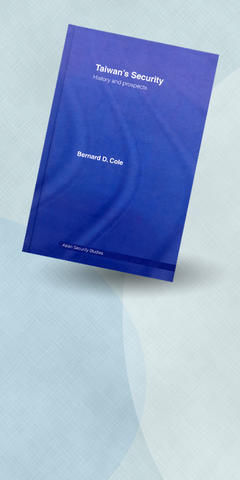In Taiwan's Security: History and Prospects, US Navy veteran Bernard Cole (unrelated to this reviewer) offers an unusually in-depth assessment of the many facets of Taiwan's defense establishment. While many publications have approached the subject from a quantitative perspective - how many tanks, aircraft, missiles and men Beijing would be capable of deploying against Taiwan in a symmetrical warfare scenario - Cole's book bores deep into Taiwanese society and highlights a series of social and institutional factors that would influence the outcome of a war with China.
Laying out the foundations to his argument, Cole contends that Taiwan's strategic positioning can be broken down into four phases - civil war; the 1949 to 1972 period of focusing on retaking China; the 1973 to 1990 transition from an offensive strategy to a defensive one; and the post-1991 emphasis on all-out defense. Parallel to these has been tutelage by the US, which while fearing that Chiang Kai-shek's (蔣介石) military adventurism in the 1950s risked sucking Washington into a war with China, nevertheless made great contributions to the modernization of the Taiwanese military.
Following his brief though sufficient historical overview, Cole then turns to the Chinese threat to Taiwan, one that has exploded in recent years with a leap in Beijing's modernization of its forces and renewed confidence in the place it occupies on the geopolitical map. Although, in Cole's view, the People's Liberation Army (PLA) continues to be dominated by army officers, a recent shift toward the PLA Air Force (PLAAF), accompanied by the acquisition and indigenous development of fourth-generation aircraft, increases the possibility of a military attack against Taiwan. The introduction of Russian-made Su-27s and Su-30s in the PLAAF also means that for the first time in years China could pose a serious challenge to Taiwan's F-16s and Mirage 2000s over the control of airspace across the Strait, although the proficiency of Chinese pilots remains in doubt.

The modernization of the PLA Navy also means that the balance of naval power in the Taiwan Strait is now in Beijing's favor. Cole argues that given Taiwan's geographical situation, mine warfare represents an especially serious threat to its economy and one it is ill-prepared and ill-equipped to deal with. China is also actively seeking aircraft carriers and mid-air refueling platforms, which would provide the PLAAF with the ability to attack Taiwan in an enveloping fashion rather than from a single direction.
In the past decade, Beijing has also markedly increased the number of DF-11 and DF-15 missiles it has deployed against Taiwan, which in his New Year speech President Chen Shui-bian (陳水扁) said now amounted to more than 1,300. Formidable though this threat may be, Cole argues, Taiwan's ballistic-missile defense systems, complemented by the ongoing relocation and hardening of high-value targets, could make it likelier that a missile attack against Taiwan would not be devastating. However, he notes that China has actively pursued the development of cruise missiles, which are much more difficult to intercept.
Cole follows his exposition of the PLA threat with a thorough, cubicle-by-cubicle look at the Taiwanese military establishment, dissecting one organization after another and explaining their roles and challenges, all the while emphasizing the need for greater cooperation and integration between the services. While this section is unlikely to appeal to the general reader, it nevertheless symbolizes Taiwan's openness to discuss these matters with researchers like Cole - something that would be unimaginable on the PRC side - and willingness to learn and improve.
Where Cole's book really stands out from other publications is in its analysis of the impact democratization, civilianization of the military and the attempt to achieve an all-volunteer service have had on Taiwan's military preparedness and ability to defend itself. Likening the Democratic Progressive Party administration's commendable, albeit daunting, attempt to create a professional defense bureaucracy to the US implemention of the Defense Reorganization Act of 1947 and the Goldwater-Nichols Act of 1986 simultaneously, Cole nevertheless identifies deficiencies in the process: a lack of funding and the failure, so far, to attract enough volunteers. Compulsory service, now at 12 months, is also far too short, in Cole's assessment, to provide soldiers with the training they need to operate in a 21st-century military. There is little doubt that democracy imposes an additional burden on national defense, as seen for example in the battle over the special arms acquisition budget and overall defense spending - something the authoritarian regime in Beijing does not have to contend with - versus other national concerns such as development and the environment.
Throughout his book, Cole also touches on a shift in Taiwan's posture from one of "passive defense" to "active defense," wherein Taipei's strategy would be to present Beijing with a credible deterrent and take the battle away from Taiwan and into China. Although this remains controversial, Taiwan's development of offensive weapons such as the Hsiung Feng III, the Hsiung Feng IIE and Tien Kung III, as well as "blackout" bombs, represents a step in that direction and recognition on Taiwan's part that purely defensive action against an overwhelming adversary might not be feasible. Aside from obvious military targets in the PRC identified by Cole, such as missile batteries and command centers, China's current fuel shortage and how this would affect its ability to sustain an attack on Taiwan should inspire Taipei to look at the possibility of targeting fuel depots there.
In the end, Cole argues, Taiwan must decide how much capital and human resources it is willing to invest in its defenses, which sends a message to its allies about how serious it is about protecting its hard-earned democracy. Although the US remains a committed ally, its responsibilities elsewhere mean that a speedy US intervention in the Taiwan Strait should not be taken for granted. Building a capability to hold the line for 15 days - Taipei's current strategy - therefore might not be enough.

The 1990s were a turbulent time for the Chinese Nationalist Party’s (KMT) patronage factions. For a look at how they formed, check out the March 2 “Deep Dives.” In the boom years of the 1980s and 1990s the factions amassed fortunes from corruption, access to the levers of local government and prime access to property. They also moved into industries like construction and the gravel business, devastating river ecosystems while the governments they controlled looked the other way. By this period, the factions had largely carved out geographical feifdoms in the local jurisdictions the national KMT restrained them to. For example,

The remains of this Japanese-era trail designed to protect the camphor industry make for a scenic day-hike, a fascinating overnight hike or a challenging multi-day adventure Maolin District (茂林) in Kaohsiung is well known for beautiful roadside scenery, waterfalls, the annual butterfly migration and indigenous culture. A lesser known but worthwhile destination here lies along the very top of the valley: the Liugui Security Path (六龜警備道). This relic of the Japanese era once isolated the Maolin valley from the outside world but now serves to draw tourists in. The path originally ran for about 50km, but not all of this trail is still easily walkable. The nicest section for a simple day hike is the heavily trafficked southern section above Maolin and Wanshan (萬山) villages. Remains of

With over 100 works on display, this is Louise Bourgeois’ first solo show in Taiwan. Visitors are invited to traverse her world of love and hate, vengeance and acceptance, trauma and reconciliation. Dominating the entrance, the nine-foot-tall Crouching Spider (2003) greets visitors. The creature looms behind the glass facade, symbolic protector and gatekeeper to the intimate journey ahead. Bourgeois, best known for her giant spider sculptures, is one of the most influential artist of the twentieth century. Blending vulnerability and defiance through themes of sexuality, trauma and identity, her work reshaped the landscape of contemporary art with fearless honesty. “People are influenced by

April 14 to April 20 In March 1947, Sising Katadrepan urged the government to drop the “high mountain people” (高山族) designation for Indigenous Taiwanese and refer to them as “Taiwan people” (台灣族). He considered the term derogatory, arguing that it made them sound like animals. The Taiwan Provincial Government agreed to stop using the term, stating that Indigenous Taiwanese suffered all sorts of discrimination and oppression under the Japanese and were forced to live in the mountains as outsiders to society. Now, under the new regime, they would be seen as equals, thus they should be henceforth